Movie Playing Cards: 5 of Spades – George Walsh
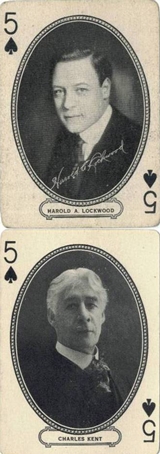
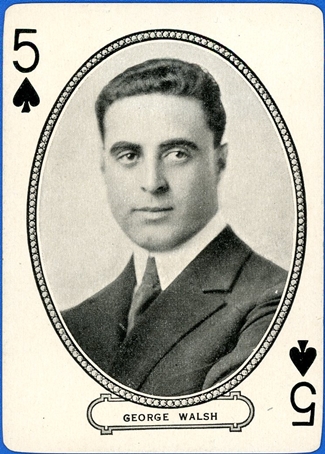
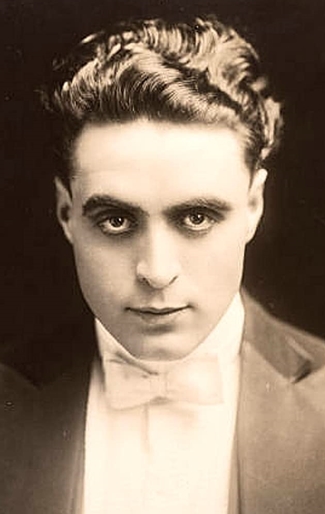 But back to our subject. Born in 1889, George Frederick Walsh followed his older brother Raoul (né Albert Edward) into pictures in the mid-1910s, having originally planned to be an attorney (he attended, however briefly, Fordham and Georgetown). He also attended New York’s High School of Commerce, where he graduated in 1911, and where he was a versatile athlete: baseball, track, cross country, swimming, rowing. This experience would stand him in good stead, at least in the Hollywood short run — certainly better than whatever he learned about commerce or pre-law.
But back to our subject. Born in 1889, George Frederick Walsh followed his older brother Raoul (né Albert Edward) into pictures in the mid-1910s, having originally planned to be an attorney (he attended, however briefly, Fordham and Georgetown). He also attended New York’s High School of Commerce, where he graduated in 1911, and where he was a versatile athlete: baseball, track, cross country, swimming, rowing. This experience would stand him in good stead, at least in the Hollywood short run — certainly better than whatever he learned about commerce or pre-law.
I don’t know what drew George to pictures in the first place, but it’s easy to imagine him being lured by the stories his brother told. Raoul had backed into pictures after working as a cowboy; his horsemanship had landed him a stage job, riding a galloping horse on a treadmill for a touring company of The Clansman. From that he got the acting bug, forgetting all about cowpunching. He wound up in New York making westerns (mostly) for Pathe, then followed D.W. Griffith to California. He loved the freewheeling fun of making pictures in those days, and he surely must have painted an enticing picture for George — “With your looks and athletic ability, you’re a natural for this stuff.” Hal Erickson at AllMovie.com says that George joined Raoul at Reliance-Mutual in 1914, but according to the IMDB, George’s first picture was an indeterminate bit in The Birth of a Nation for D.W. Griffith. Or more likely a series of bits; Griffith was economical in his use of extras, and George may well have been one of those who saw himself on screen fighting on both sides of a battle. Raoul played John Wilkes Booth in Birth, but was already on his way to a director’s career (it would extend to 1964; Raoul Walsh remains a favorite director among critics and historians).
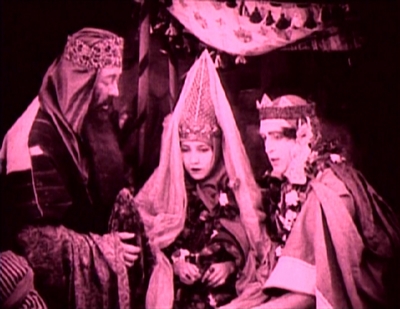 George did get his first breaks in Reliance-Mutual pictures directed by Raoul and others, moving up the cast list till he was top-billed, and first drawing the eye of Variety’s reviewer in Raoul’s Blue Blood and Red (1916): “The kid is clever…a fine, manly looking chap, full of athletic stunts…” By this time, both Raoul and George were working for William Fox, and soon George worked again for D.W. Griffith. Here he is as the Bridegroom of Cana in the Judean Story section of Intolerance, receiving the bad news that the wine supply has run out. With him are 17-year-old Bessie Love (still several years from her own stardom) as the Bride of Cana and William Brown as the father of the bride.
George did get his first breaks in Reliance-Mutual pictures directed by Raoul and others, moving up the cast list till he was top-billed, and first drawing the eye of Variety’s reviewer in Raoul’s Blue Blood and Red (1916): “The kid is clever…a fine, manly looking chap, full of athletic stunts…” By this time, both Raoul and George were working for William Fox, and soon George worked again for D.W. Griffith. Here he is as the Bridegroom of Cana in the Judean Story section of Intolerance, receiving the bad news that the wine supply has run out. With him are 17-year-old Bessie Love (still several years from her own stardom) as the Bride of Cana and William Brown as the father of the bride.
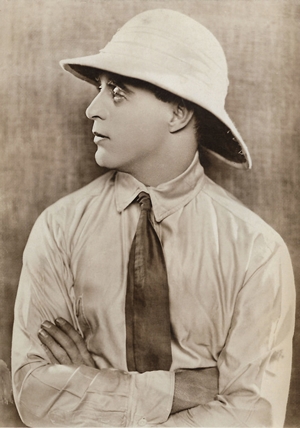 “Walsh is in his glory scaling walls, climbing trees, foiling cops, etc. There are a couple of corking fights where he handles anywhere from a dozen to twenty opponents at a time”; From Now On (’20), “What may be held up for approval is the hard work which George Walsh invests in it.” The image conjured up from these reviews is a series of lightweight adventures distinguished by George’s prowess; as brother Raoul, who directed From Now On, said years later, “Well, anything with him wouldn’t be too heavy.”
“Walsh is in his glory scaling walls, climbing trees, foiling cops, etc. There are a couple of corking fights where he handles anywhere from a dozen to twenty opponents at a time”; From Now On (’20), “What may be held up for approval is the hard work which George Walsh invests in it.” The image conjured up from these reviews is a series of lightweight adventures distinguished by George’s prowess; as brother Raoul, who directed From Now On, said years later, “Well, anything with him wouldn’t be too heavy.”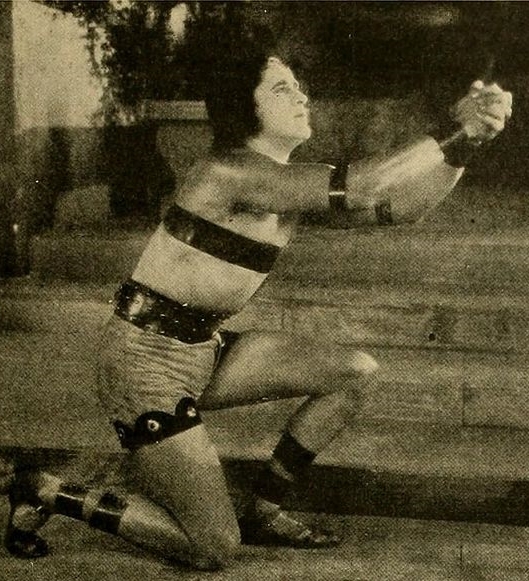 Then came what looked like the break of a lifetime: George Walsh was chosen by writer June Mathis to play the title role in Metro’s screen adaptation of Ben-Hur, to be shot on location in Rome. The role was coveted by every actor in movies except Jackie Coogan. The most popular choice, Rudolph Valentino, was out of play because of a contract dispute with Famous Players-Lasky; until they settled their differences, the studio wasn’t about to let him work for anyone else. Mathis ordered tests, dozens of them, and Walsh won out. In his recounting of the Ben-Hur production in The Parade’s Gone By, Kevin Brownlow tells us that there was little enthusiasm in Hollywood for the choice; George was a fine physical specimen, they all said, but not that strong an actor.
Then came what looked like the break of a lifetime: George Walsh was chosen by writer June Mathis to play the title role in Metro’s screen adaptation of Ben-Hur, to be shot on location in Rome. The role was coveted by every actor in movies except Jackie Coogan. The most popular choice, Rudolph Valentino, was out of play because of a contract dispute with Famous Players-Lasky; until they settled their differences, the studio wasn’t about to let him work for anyone else. Mathis ordered tests, dozens of them, and Walsh won out. In his recounting of the Ben-Hur production in The Parade’s Gone By, Kevin Brownlow tells us that there was little enthusiasm in Hollywood for the choice; George was a fine physical specimen, they all said, but not that strong an actor.Things didn’t go well for Ben-Hur in Italy. Sets weren’t ready, equipment wasn’t available, crews couldn’t speak English, supervisors couldn’t speak Italian. Matters began in a state of disorganization and degenerated into hopeless chaos. June Mathis, ostensibly the production supervisor as well as scriptwriter, was barred from the set by director Charles Brabin — not that there was much set to bar her from. While construction dawdled along, the company adjourned to Anzio to shoot the sea battle; Brabin sat around guzzling wine and regaling the crew with long-winded stories while underlings haggled with local bureaucrats, and hundreds of extras idled sweltering on the beach. When cameras finally rolled, everything went wrong.
Well, I needn’t go on; you can get the whole story from Brownlow. By autumn of 1924, the newly-formed MGM had inherited this mess, and the new bosses, L.B. Mayer and Irving Thalberg, took drastic action. Brabin was fired because his footage was awful. June Mathis was fired because she had been the supposed supervisor of this fiasco, and had insisted on shooting in Rome in the first place. And George Walsh was fired because Mathis had hired him — besides, MGM wanted to build up their rising star Ramon Novarro, and since Walsh hadn’t yet appeared on film it would cost only the price of a ticket home to get rid of him. Walsh and Bushman (who was one of the few survivors of the purge) read about the changes in the newspapers. The whole company — what was left of it — was ordered back to California at once, where Mayer and Thalberg could keep a close eye on things.
It was all a bitter pill for George. “You know, Frank,” he told Bushman, “I felt this was going to happen. But to leave me over here for so long, to let me die in pictures — and then to change me!” Because MGM, in damage-control mode, kept mum about the state of the production and the reasons for such sweeping changes, the impression was left that George simply couldn’t cut it — just as everyone had suspected.
Could he have cut it? Maybe, maybe not. June Mathis shrugged off her own dismissal, saying her chief regret was for Walsh: “I had complete faith in his ability to play Ben-Hur,” she told Photoplay. “I realize many other people did not believe in him, but the same thing occurred when I selected Rudolph Valentino for the role of Julio in The Four Horsemen. Valentino justified himself, and I am confident that Mr. Walsh would have done the same thing. Actually, he was given no opportunity to succeed or fail. He was withdrawn without a chance. Indeed, Mr. Novarro was in Rome for three days before Mr. Walsh was notified that he had been succeeded in the leading role.” Nevertheless, in Hollywood — then as now — image was everything. George slunk home a “failure”, even though he had not faced the cameras for so much as a frame of film.
He didn’t exactly “die in pictures”, but in an age where a star was expected to appear in a new picture several times a year — even every few weeks — George Walsh was off the screen from December 1923 to October ’25. He might as well have moved to Tibet and become a hermit. He had lost momentum, and he never really got it back. His vehicles continued as they had before, with titles like American Pluck, The Kick-Off, Striving for Fortune and His Rise to Fame, but the scripts were more formulaic than ever, the productions cheaper and more slapdash, the companies increasingly fly-by-night. The kid was looking less clever than he once had; more important, he was no longer a kid. His last starring vehicle was the inaptly named Inspiration (1928), which Variety termed “for second run houses in not too particular neighborhoods.”

After the coming of sound Walsh made a few movies, but was never again top-billed. Supporting roles (often in brother Raoul’s pictures like Me and My Gal, The Bowery and Under Pressure) slid into bits — like this one in Cecil B. DeMille’s Cleopatra (1934), as a courier bringing Antony (Henry Wilcoxon) and Cleopatra (Claudette Colbert) the bad news that Octavian is on the march. After Raoul’s Klondike Annie and a couple of Poverty Row westerns in 1936, George decided to call it a day in pictures, and retired from the screen to work as a racehorse trainer for the Hollywood horsey set.
All in all, George Walsh didn’t have such a bad run; his pictures were breezy, undemanding fun in their day and he had a definite following. Getting canned from Ben-Hur was a blow, no doubt, but how much of his subsequent career slide was due to his two years out of circulation, and how much was simply because his day was done, is something I guess we’ll never know. Like any other star, he arrived, he blazed, and he waned, then (unlike some) lived to a ripe old age: George Walsh was 92 when he passed away in Pomona, Calif. in 1981.

Thanks for stopping by and commenting, Art. FYI, all four of your attempts were successful, but the last three came through before I had a chance to approve the first.
Re: Anonymous, her name was Winifred Craven or Cravens? I miss those days G.W. with you guys on Valley, if I knew how to contact you I would.
Art
Forth attempt to send
Welcome, Anon, and thanks for the correction! Unfortunately, at this late date I can't seem to pinpoint where I got the idea that George had married only once, but I appreciate your setting the record straight.
I must correct you on your statement in this article that George Walsh only married once. That is not true. I was married to his oldest Son, Thomas Walter Walsh and also knew his youngest son, George Walsh. I married Tom in 1982. I met his Dad one time. He was in a nursing home and suffering from dementia. Soon after, his Father passed away. We attended the funeral but not many showed up. We also attended his Uncle's funeral, Raoul Walsh. He passed before George did. We went to the funeral and Gregory Peck attended and was one of the pall bearers. So George Walsh, Sr. was married for many years to my ex-husband's mother. I never met her and cannot remember her name I am sorry to say. Tom and I divorced in 1990 and I have not seen him since.